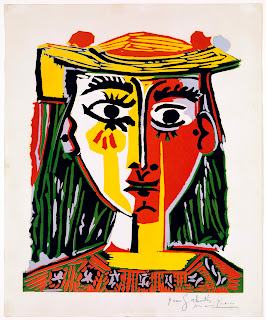When I first arrived in Florence 25 years ago, admission to the Uffizi Gallery was $1--now it is $15. Sign of the times. But every January, the Sala delle Poste Reali, across the Uffizi, hosts an art show with free admission, featuring art from the Uffizi storerooms.
What is kept from sight in Uffizi storage is astonishing--I'm sure many a museum in the world would love to beg, borrow or acquire no less than a work by Botticelli (sound familiar? he is the author of the Birth of Venus as well as the Primavera and many other famous paintings) that I saw with my own eyes a few years ago in the first edition of I Mai Visti (The Never Seen) at the Poste Reali.
The Poste Reali literally translates as "The Royal Post Office." Whether it was or not I don't know but I do know that it is now used as an exhibition space, and currently hosts Volti Svelati (Faces Unveiled), a collection of Roman busts normally hidden away.
furrowed brows and
even large noses and oversize ears.
Portraying subjects as realistically as possible was due to the idea that age exemplifies wisdom, as in contrast to the idealized figures, which came later, when Rome was a full-fledged empire.
Of course Domitia, the wife of Emperor Domitian (no, they were not related before marriage), reigning as empress between 81 and 96 A.D. is represented by a flattering sculpture in marble.
The catalogue's photographer, Maria Brunori, who is specialized in classical sculpture, told me that the bust was done when Domitia was over 50 (which, for the time meant she was elderly). She also said while her features are true to life, the artist practiced an early form of botox, removing all wrinkles so that Domitia would appear as if in her late 20s.
Portraying subjects as realistically as possible was due to the idea that age exemplifies wisdom, as in contrast to the idealized figures, which came later, when Rome was a full-fledged empire.
Of course Domitia, the wife of Emperor Domitian (no, they were not related before marriage), reigning as empress between 81 and 96 A.D. is represented by a flattering sculpture in marble.
The catalogue's photographer, Maria Brunori, who is specialized in classical sculpture, told me that the bust was done when Domitia was over 50 (which, for the time meant she was elderly). She also said while her features are true to life, the artist practiced an early form of botox, removing all wrinkles so that Domitia would appear as if in her late 20s.
Another Roman empress, Vibia Sabina--this time a distant cousin of husband Hadrian--is also in the line-up, distinguished by her noble demeanor and life-like braid wrapped around her head. Among other things, Vibia Sabina's spouse is known for establishing the northern boundary of the Roman Empire in Britain, still called Hadrian's Wall. Also related to a prior Roman Emperor, Trajan, Sabina was remarkably powerful for a woman in her day and age--her profile appeared
on Roman currency.
Hadrian and Vibia Sabina had no children, one reason being that Hadrian's love was directed towards another, a beautiful young Greek boy named Antinous. Of course, taxpayer revenue being no problem, a sculptor was commissioned to carve a bust of Antinous in marble, also present in the exhibition.
There was no need to idealize his stone portrait as Antinous came to an untimely end, misstepping when descending from a boat only to fall and drown in the Nile river. Was he pushed?
We will never know.
In any case, a bereaved Hadrian proclaimed his young dead lover a god in the Roman religion. In this context, Antinous was often associated with fertility and rebirth, consequently being identified with and depicted as the Egyptian god Osiris or another Roman god, Bacchus.
Cute, huh? See the spring flowers in his hair, which would be associated with rebirth.
Hadrian, however, gave equal time to his wife Vibia Sabina only after her death,
creating her as a goddess as well.
"Faces Unveiled" of "The Never Seen" series are on view only through January 29 (open 10 am - 5 pm, free admission). If something more modern is to your liking, catch the Picasso show at Palazzo Blu in Pisa, extended to February 5
(see report in the previous blog post
Modern Music, Modern Art in Tuscany).
I have been writing a lot about art and music lately--I promise that the next Beautiful Florence blog post will be on food.
Beside art, isn't that what Italy is all about? Stay tuned.












